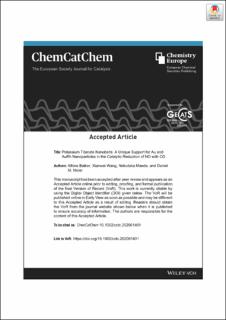Please use this identifier to cite or link to this item:
https://doi.org/10.21256/zhaw-20776| Publication type: | Article in scientific journal |
| Type of review: | Peer review (publication) |
| Title: | Potassium titanate nanobelts : a unique support for Au and AuRh nanoparticles in the catalytic reduction of NO with CO |
| Authors: | Baiker, Alfons Wang, Xianwei Maeda, Nobutaka Meier, Daniel Matthias |
| et. al: | No |
| DOI: | 10.1002/cctc.202001401 10.21256/zhaw-20776 |
| Published in: | ChemCatChem |
| Volume(Issue): | 13 |
| Issue: | 1 |
| Page(s): | 438 |
| Pages to: | 444 |
| Issue Date: | 13-Oct-2020 |
| Publisher / Ed. Institution: | Wiley |
| ISSN: | 1867-3880 1867-3899 |
| Language: | English |
| Subjects: | Bimetallic AuRh; Potassium titanate nanobelt; NO reduction with CO; Isocyanate; In situ IR spectroscopy |
| Subject (DDC): | 660: Chemical engineering |
| Abstract: | The catalytic reduction of NO with CO was examined over monometallic Au and bimetallic AuRh nanoparticles supported on potassium titanate (K2Ti8O17) nanobelts (KTN) and TiO2. The highly crystalline KTN, prepared from TiO2 by a hydrothermal process using KOH, were several μm long and ca. 8 nm wide. Both Au and bimetallic AuRh catalysts showed a striking enhancement of the catalytic performance with KTN as support, compared to corresponding TiO2- supported catalysts. The reasons for this behavior could be traced back using in situ diffuse reflectance infrared Fourier transform spectroscopy in tandem with modulation excitation spectroscopy, which proved that the KTN support promotes the formation of surface nitrate (-NO3-), carbonate (-CO32-), and isocyanide (-NCO) species. In particular, the combination of KTN with bimetallic AuRh nanoparticles results in the facile formation of isocyanide, which is a pivotal intermediate for producing dinitrogen molecules via the reaction with NO; NCO(a) + NO(a) → N2 + CO2. |
| URI: | https://digitalcollection.zhaw.ch/handle/11475/20776 |
| Fulltext version: | Accepted version |
| License (according to publishing contract): | Licence according to publishing contract |
| Restricted until: | 2021-10-13 |
| Departement: | School of Engineering |
| Organisational Unit: | Institute of Materials and Process Engineering (IMPE) |
| Appears in collections: | Publikationen School of Engineering |
Files in This Item:
| File | Description | Size | Format | |
|---|---|---|---|---|
| 2020_Wang-etal_Potassium-Titanate-Nanobelts_cctc.pdf | Accepted Version | 3.73 MB | Adobe PDF |  View/Open |
Show full item record
Baiker, A., Wang, X., Maeda, N., & Meier, D. M. (2020). Potassium titanate nanobelts : a unique support for Au and AuRh nanoparticles in the catalytic reduction of NO with CO. ChemCatChem, 13(1), 438–444. https://doi.org/10.1002/cctc.202001401
Baiker, A. et al. (2020) ‘Potassium titanate nanobelts : a unique support for Au and AuRh nanoparticles in the catalytic reduction of NO with CO’, ChemCatChem, 13(1), pp. 438–444. Available at: https://doi.org/10.1002/cctc.202001401.
A. Baiker, X. Wang, N. Maeda, and D. M. Meier, “Potassium titanate nanobelts : a unique support for Au and AuRh nanoparticles in the catalytic reduction of NO with CO,” ChemCatChem, vol. 13, no. 1, pp. 438–444, Oct. 2020, doi: 10.1002/cctc.202001401.
BAIKER, Alfons, Xianwei WANG, Nobutaka MAEDA und Daniel Matthias MEIER, 2020. Potassium titanate nanobelts : a unique support for Au and AuRh nanoparticles in the catalytic reduction of NO with CO. ChemCatChem. 13 Oktober 2020. Bd. 13, Nr. 1, S. 438–444. DOI 10.1002/cctc.202001401
Baiker, Alfons, Xianwei Wang, Nobutaka Maeda, and Daniel Matthias Meier. 2020. “Potassium Titanate Nanobelts : A Unique Support for Au and AuRh Nanoparticles in the Catalytic Reduction of NO with CO.” ChemCatChem 13 (1): 438–44. https://doi.org/10.1002/cctc.202001401.
Baiker, Alfons, et al. “Potassium Titanate Nanobelts : A Unique Support for Au and AuRh Nanoparticles in the Catalytic Reduction of NO with CO.” ChemCatChem, vol. 13, no. 1, Oct. 2020, pp. 438–44, https://doi.org/10.1002/cctc.202001401.
Items in DSpace are protected by copyright, with all rights reserved, unless otherwise indicated.